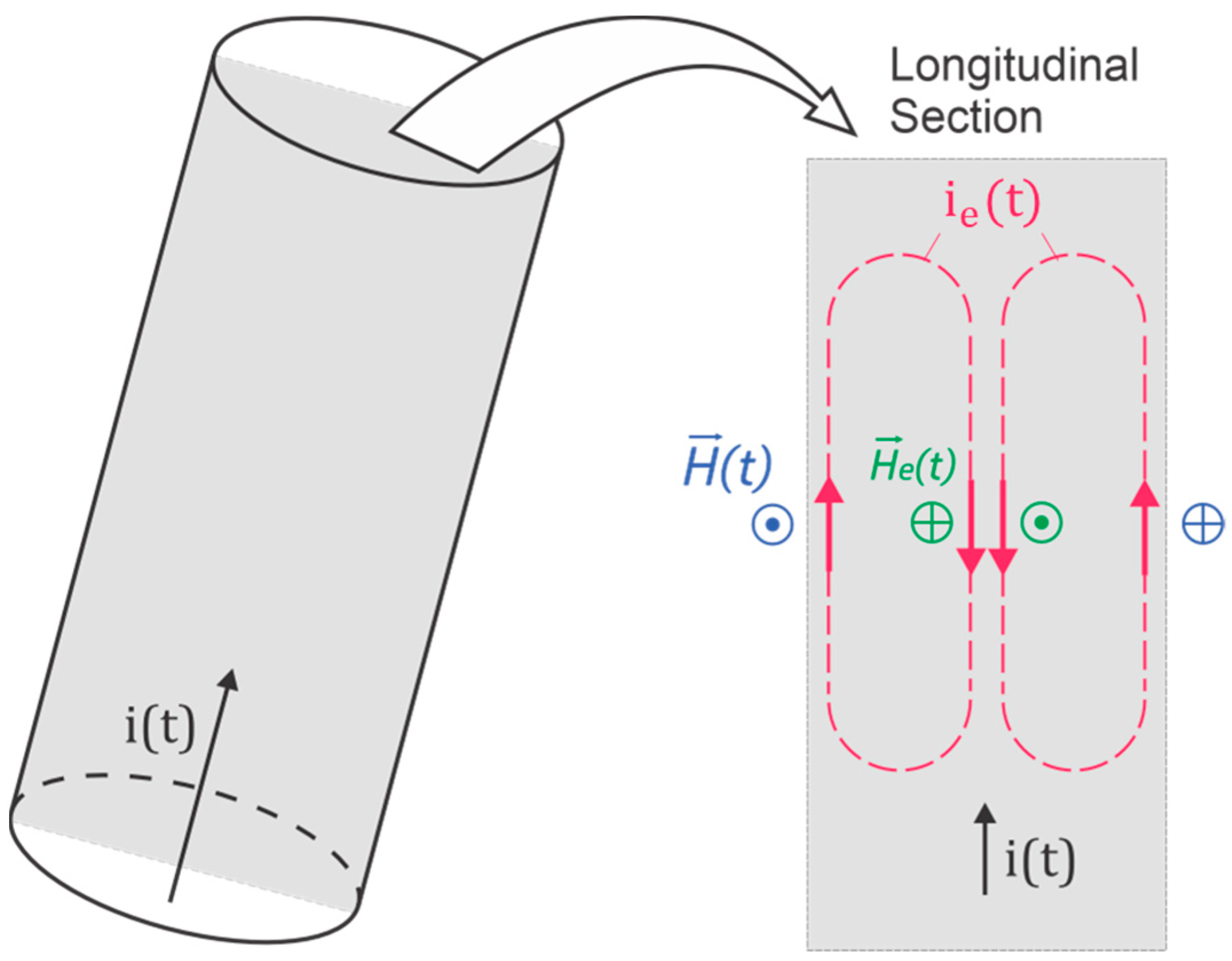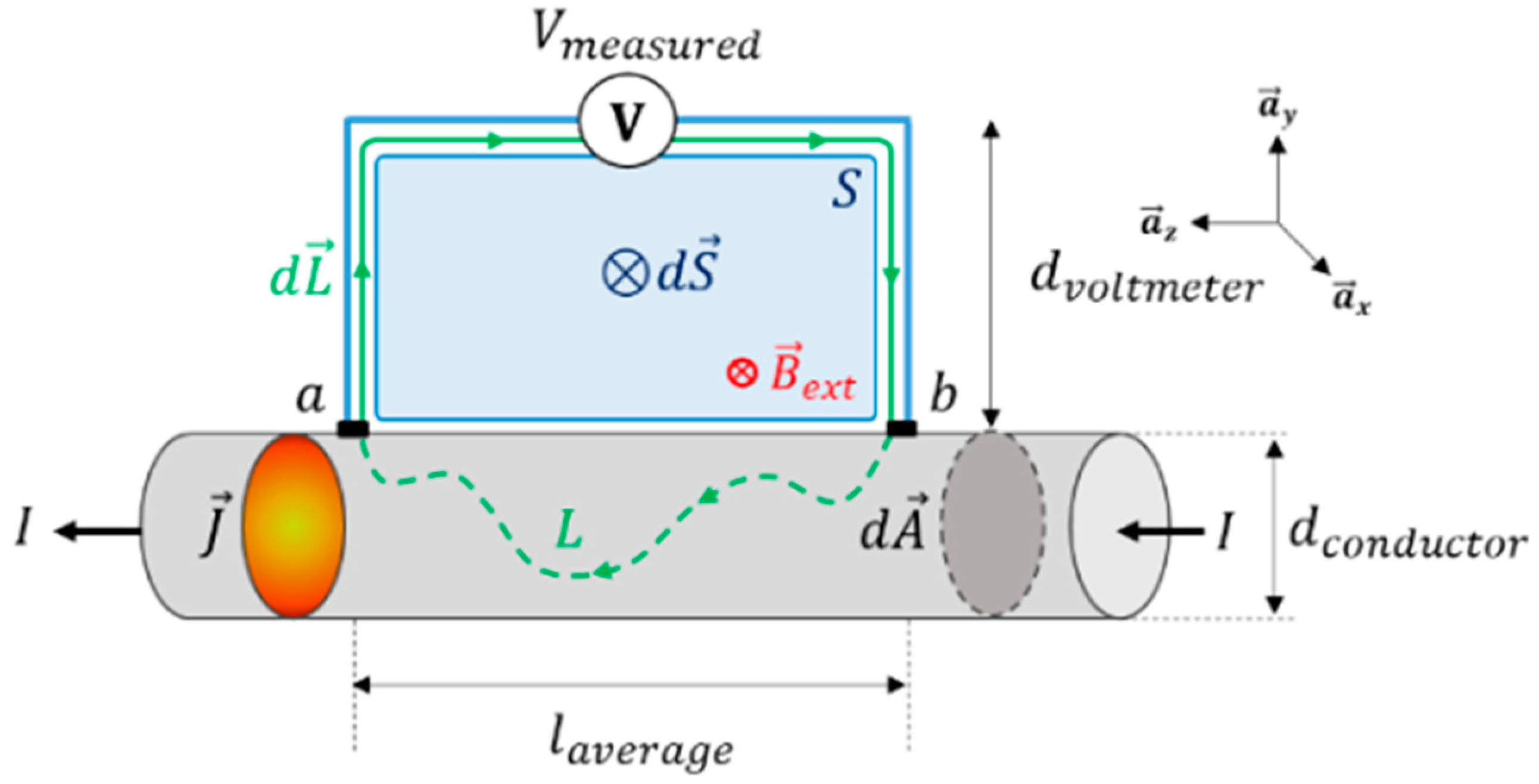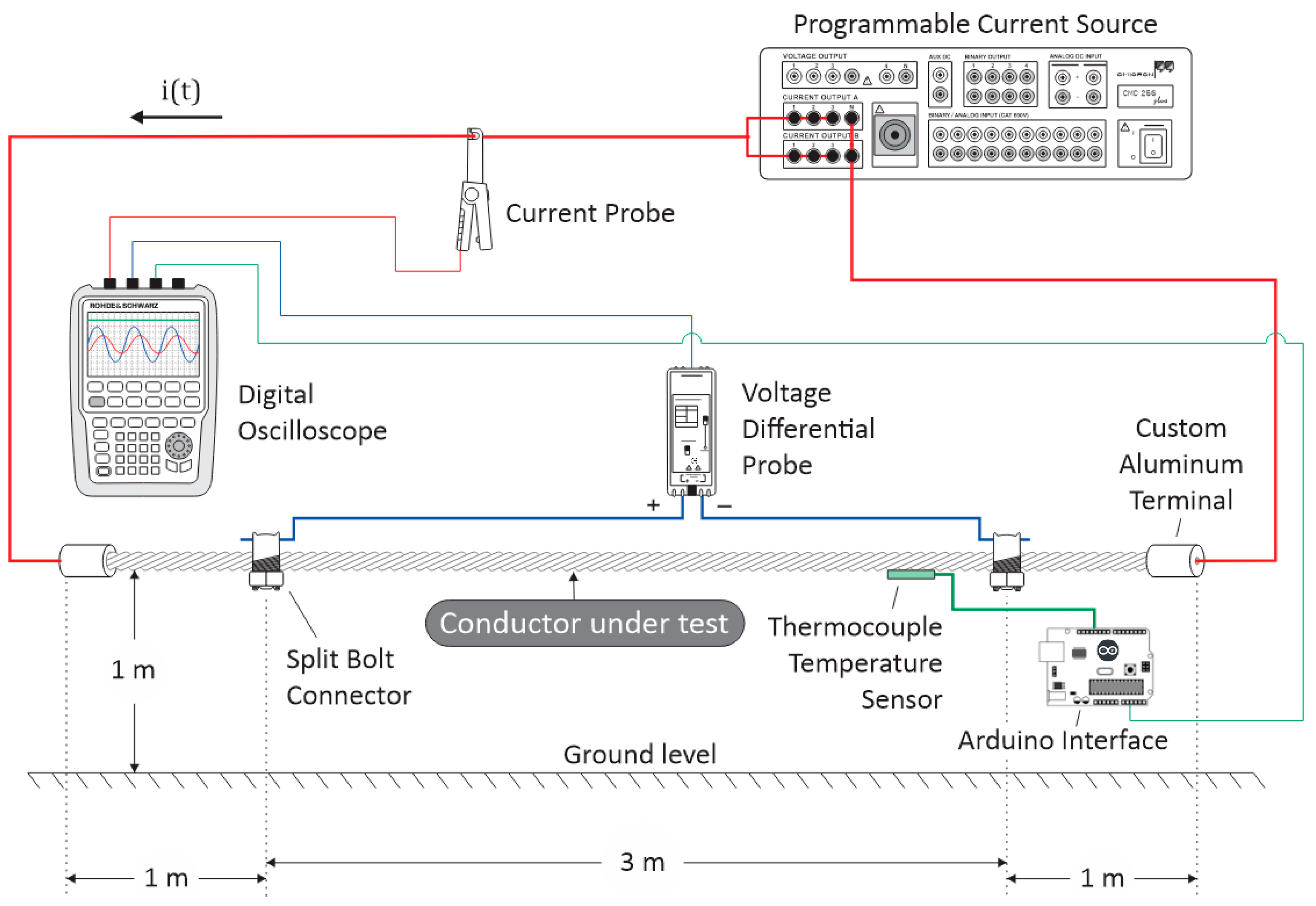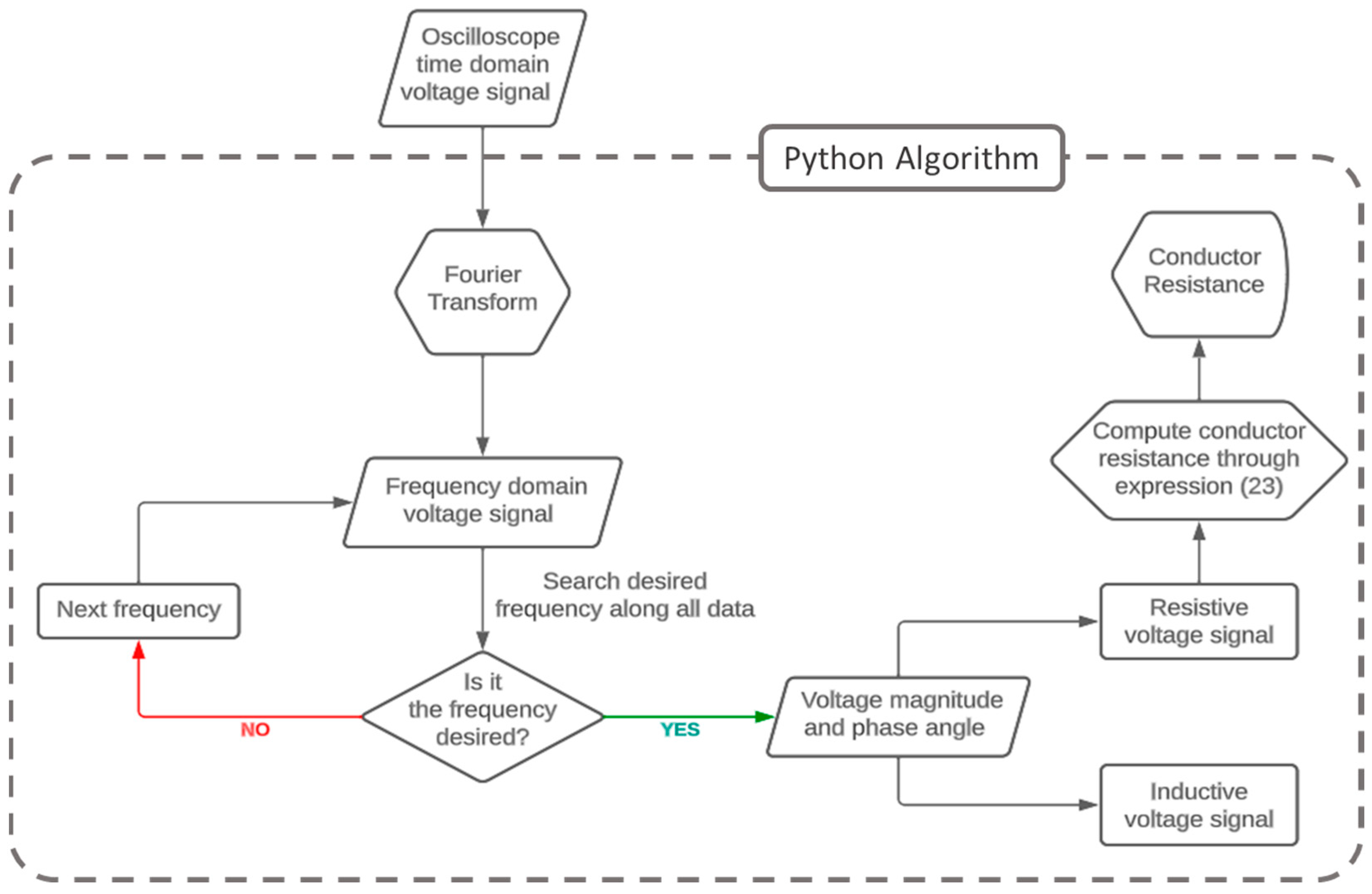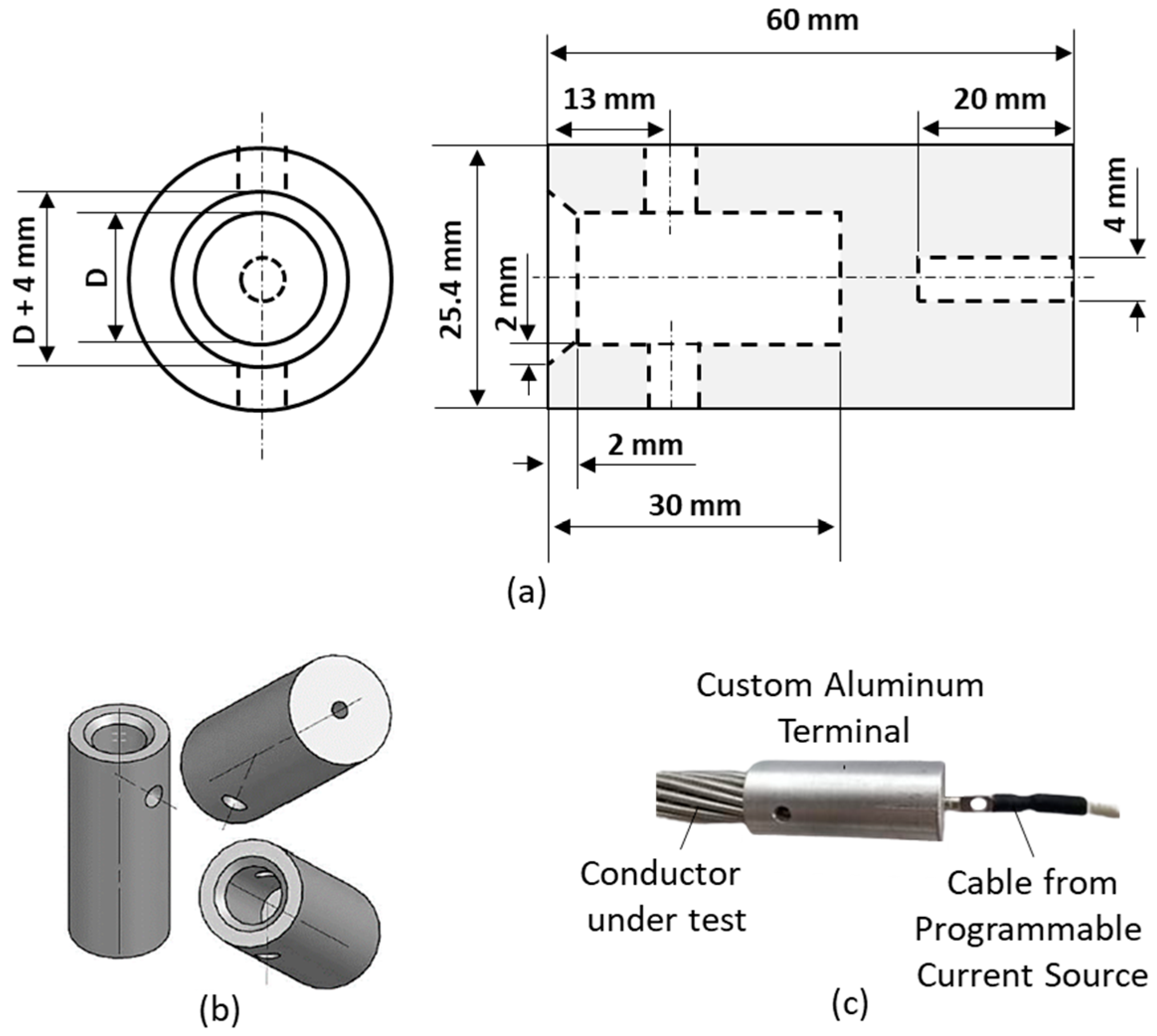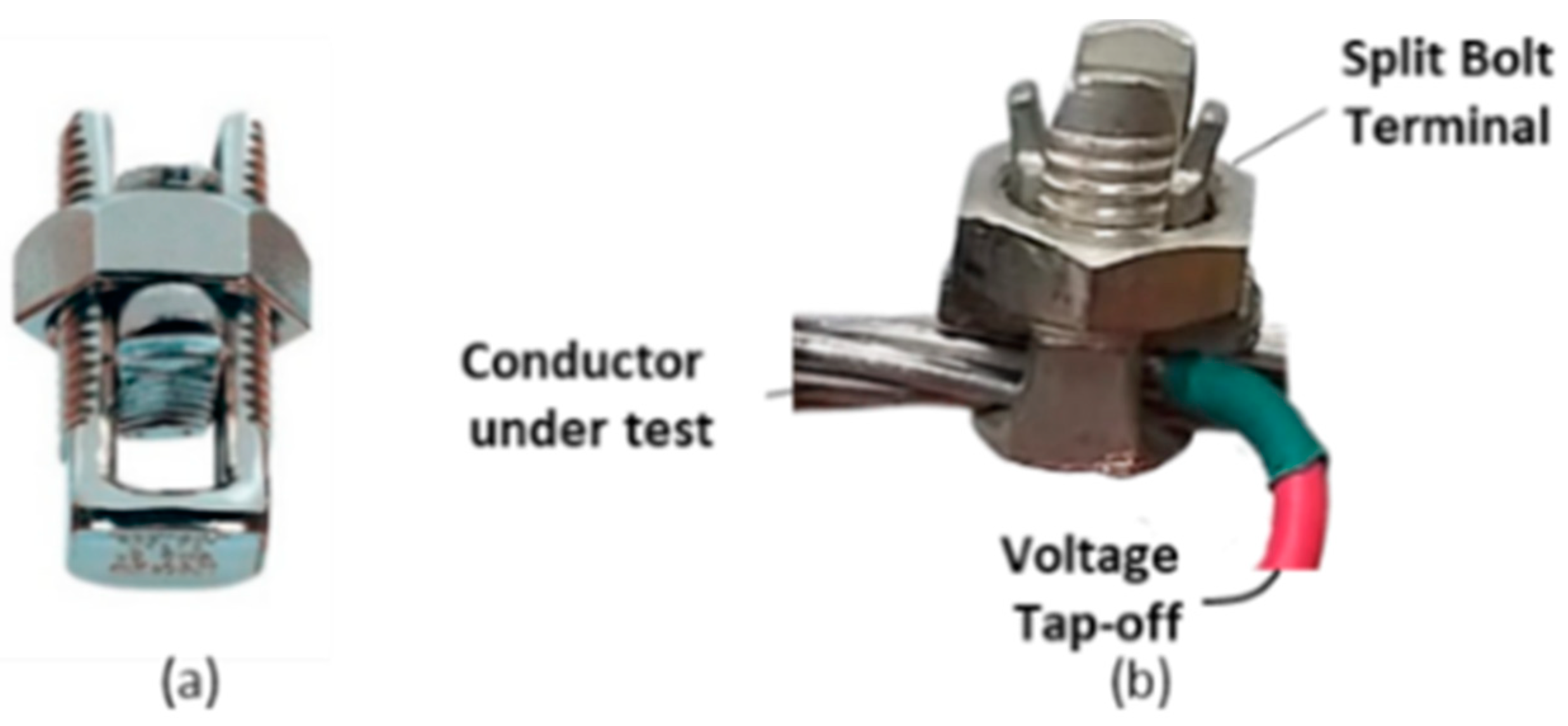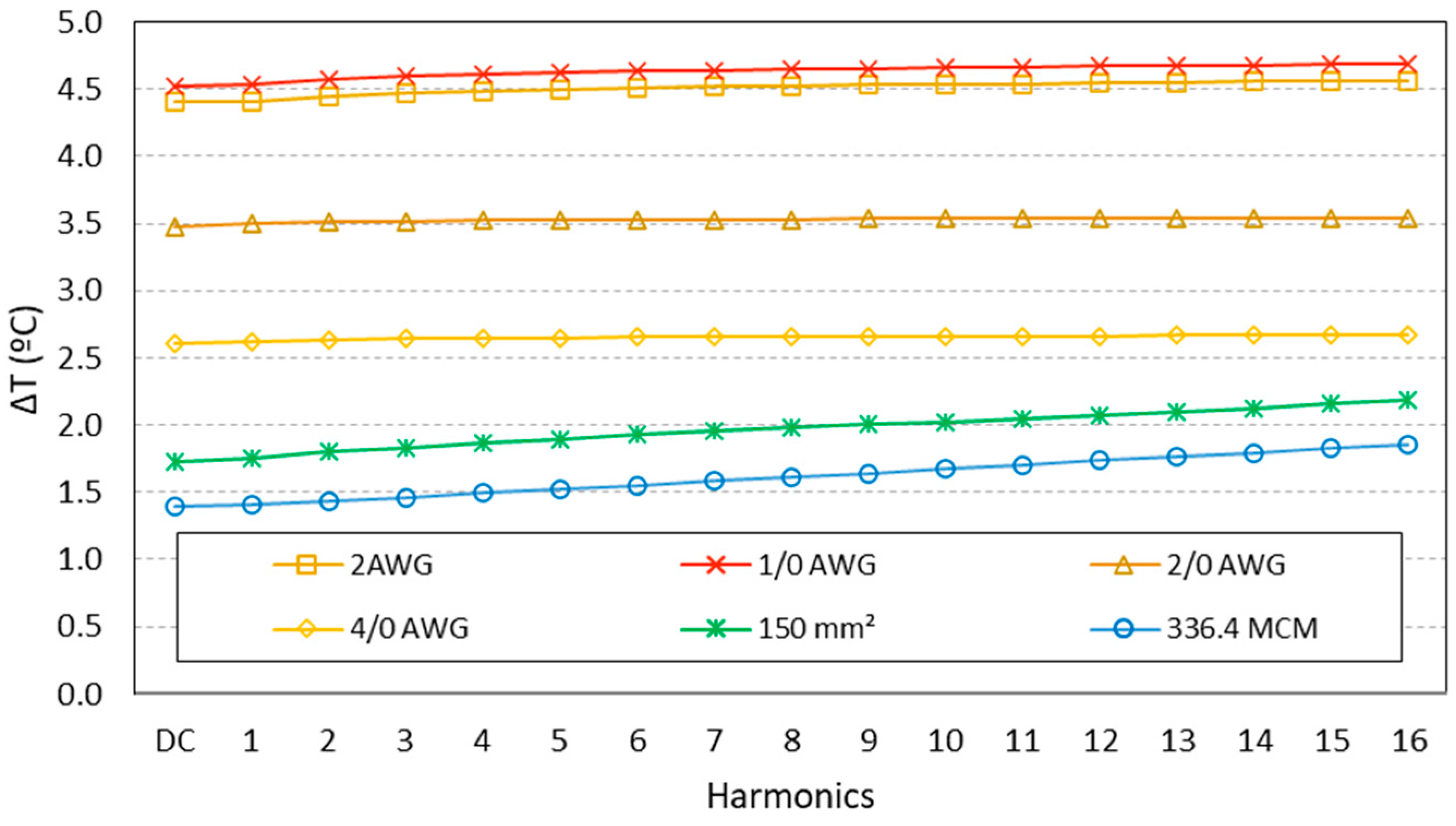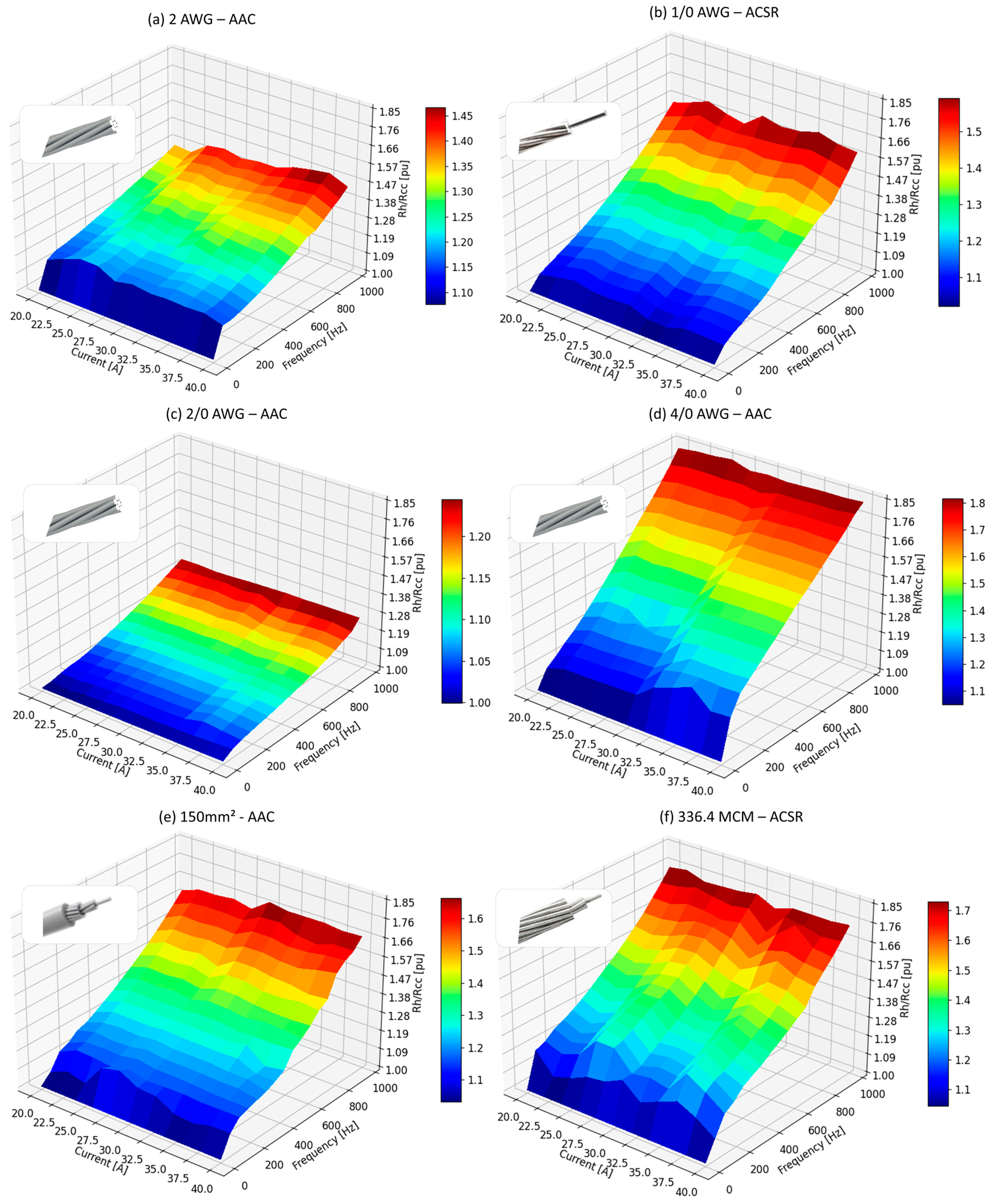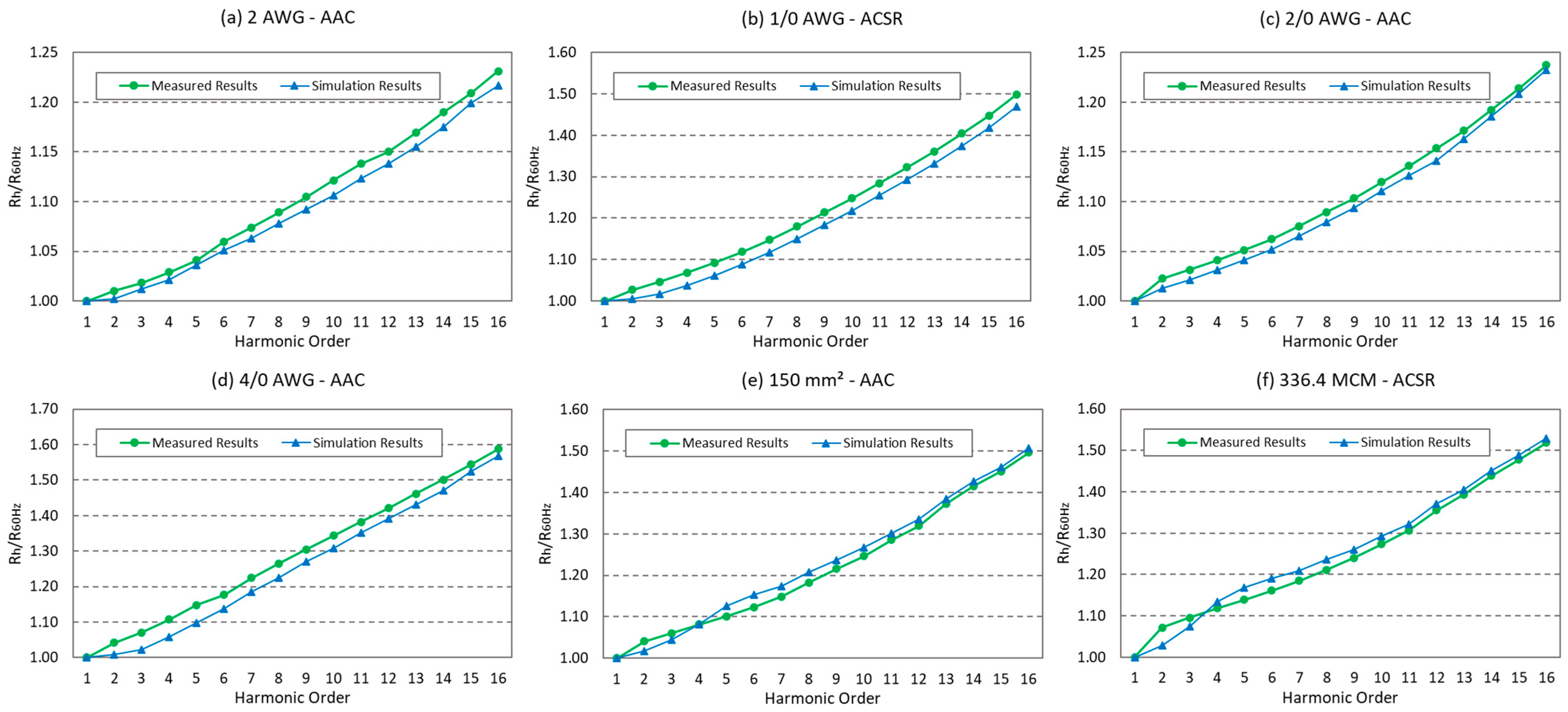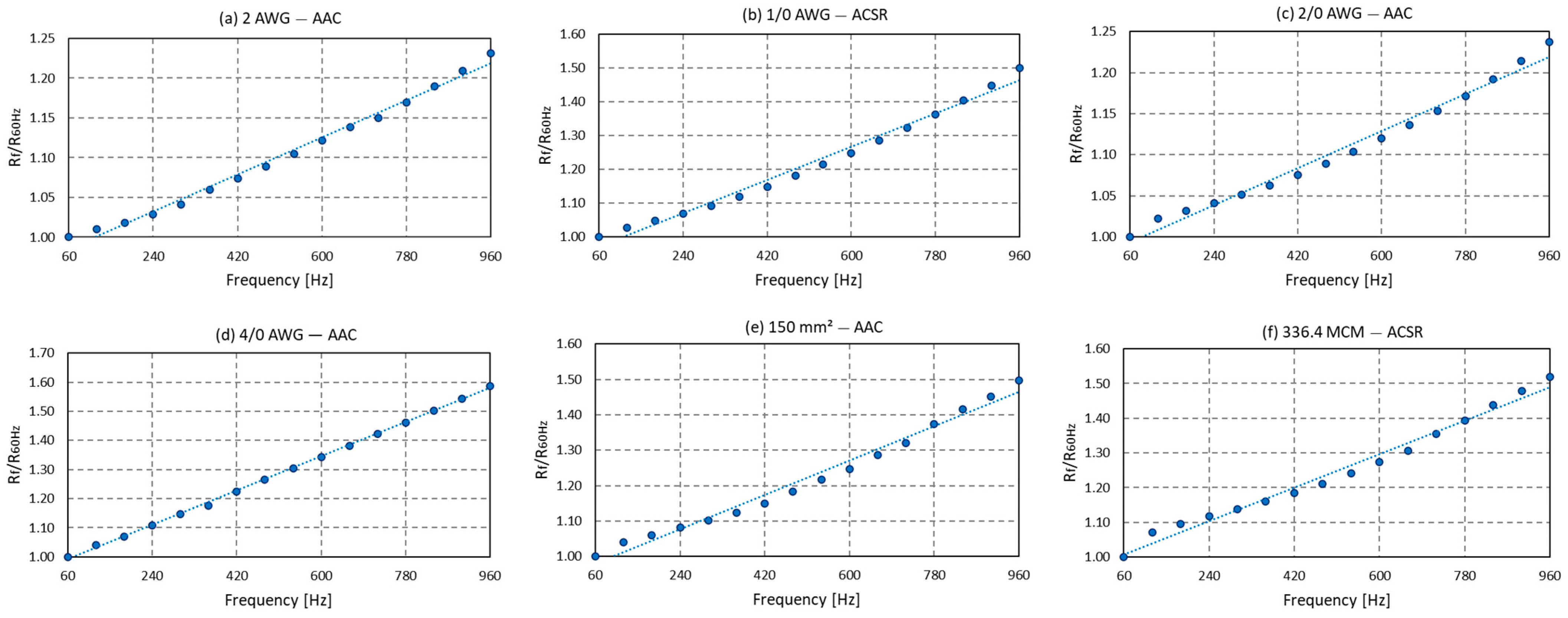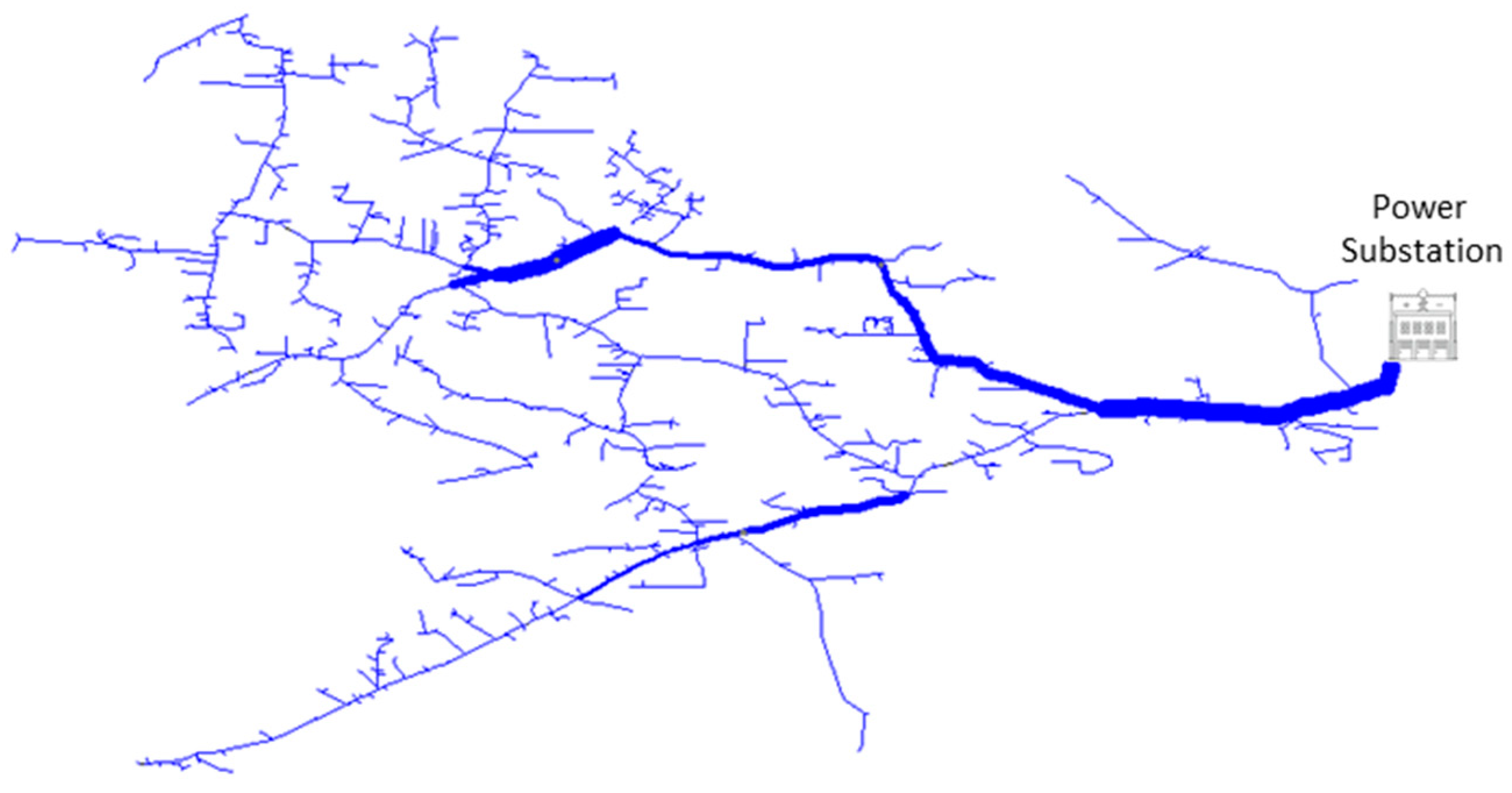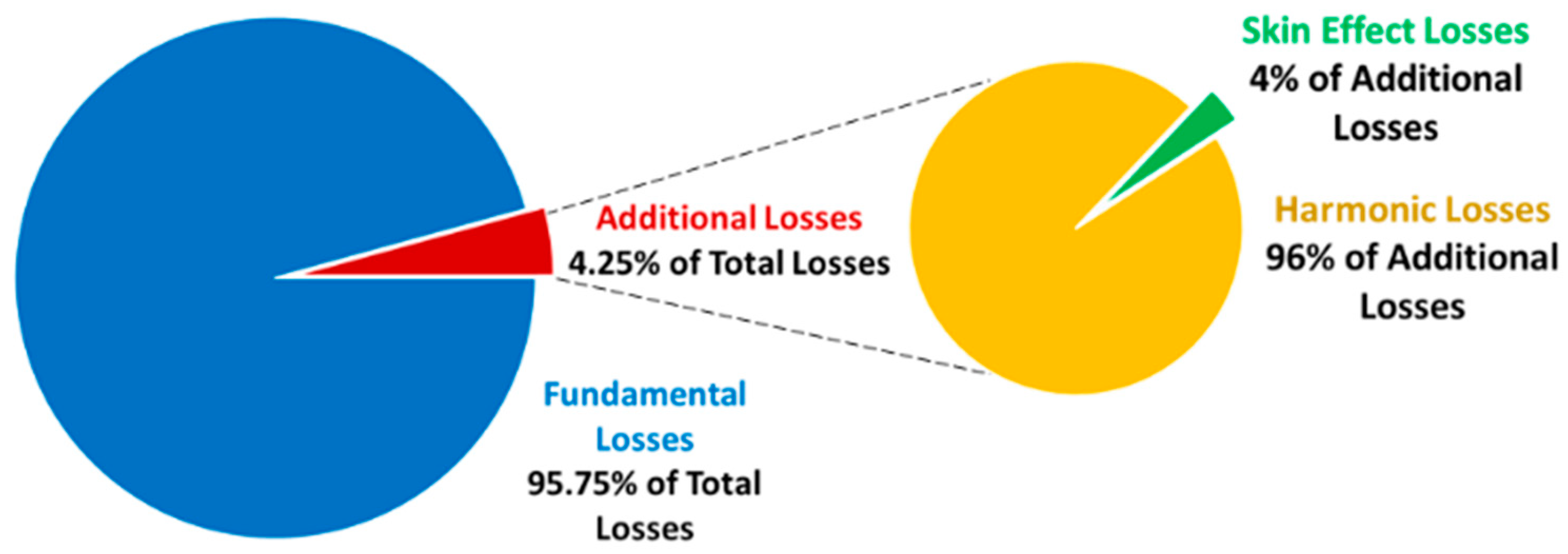1. Introduction
The current harmonic and interharmonic components, which encompass an inseparable reality of electrical systems, have long been studied and quantified by researchers and engineers around the world. The presence of these components, particularly those operating at higher frequencies, on any electric circuit, causes an increase in the resistance of conductors due to the skin effect phenomenon.
Subsequently, scientific publications focused on investigating the skin effect by conducting measurements to establish a relationship between the resistance of the conductor at direct current (RDC) and the resistance of the conductor at alternating current (RAC), considering variations in frequency, such as [
1]. Scientific literature that mathematically covers the phenomenon [
2,
3] was consolidated by utilizing Bessel’s equation as a faithful representation of the skin effect, where the particular behavior of the magnetic field for different conductors was later clarified, such as in hard wires and flexible cables [
4].
Furthermore, laboratory experiments have addressed specific issues related to the measurement of electrical resistance in conductors at different frequencies [
5]. These experiments involved the development of an electrical configuration capable of quantifying resistance under varying electric currents. In parallel, computer simulations have become essential tools for scientific advancements [
6]. The use of finite element-based simulated meshes has enabled detailed analyses of the electromagnetic performance of various conductors and electrical equipment geometries.
Building upon previous research, recent scientific studies have focused on practical applications of the phenomenon, such as power losses in arc furnace buses [
6]. Additionally, the scientific community has extensively examined the reliability of mathematical solutions provided by computer simulations [
7].
However, a shared characteristic observed in the various studies conducted [
6,
7,
8,
9] is the lack of measurements and real-world applicability of the data to analyze the impact of the skin effect on electric power systems. This knowledge gap highlights the need for a better understanding of quantifying the skin effect. In line with this observation, the study conducted in [
10] focused on the practical implications of the skin effect on electrical equipment, such as transformers, resulting in increased power losses.
Similarly, the study in [
11] examined the behavior of the skin effect in a 69 kV conventional transmission line with ground return, offering practical insights into the phenomenon, albeit without fully considering the complex nature of the entire electrical system. Despite the innovative mathematical modeling presented, the study primarily addresses the individual impact of the skin effect on the specific electrical device, neglecting the comprehensive analysis of electrical power distribution systems as a whole.
While previous studies have explored the behavior of the skin effect in transformers and transmission lines, there are studies, such as [
12,
13], that leverage this phenomenon to develop a control logic for protecting a railway system with direct current rails. Specifically, this study presents a precise methodology for analyzing the skin effect in the time domain, accurately reproducing fault currents in the rails. In contrast to earlier research, this study satisfactorily considers the intricate complexities of the local power distribution system. In addition to the mentioned papers, [
14] also addresses the phenomenon, pointing out that eddy currents and the skin effect play an important role in electrical machines and power systems.
The impact of harmonic components on eddy current losses in the core of soft magnetic materials is discussed in [
13]. The study involves the creation of a 3D model based on the magnetic behavior of the material. Furthermore, the quantification of losses resulting from the skin effect induced by harmonic components was carried out. Ref. [
15] presents an approach for analyzing the skin effect in a wire using finite elements. Although this study makes significant contributions to calculating conductor resistance as a function of frequency, it lacks laboratory exploration and measurement, which is an aspect addressed in the current study. Ref. [
16] presents a singular contribution on cables losses via a computational method based on a probabilistic approach that predicts some features on litz cables. Despite the singular contribution that this study makes to quantifying losses on conductors, it lacks a focus on electrical power system conductors that the current study aims to fulfill.
The study presented herein has as its objective to present the quantification of resistance increase due to the skin effect in conductors used on power distribution networks. To undertake this study, it is crucial to have a comprehensive understanding of the physical and mathematical aspects of the problem, as well as to conduct laboratory measurements. This allows for the quantification of the skin effect in the electrical resistance of various types of conductors in power distribution lines. Additionally, the expressions estimated for representing the skin effect in conductors were applied to the IEEE 8500-node test feeder utilizing the OpenDSS software, which assesses the impact that the suggested approach has in simulation time and the influence of the skin effect on power distribution losses. It is important to point out that not only are the results from these simulations displayed on item 4.2, but also a detailed approach regarding the electrical characteristics of IEEE 8500-node test feeder. The subsequent section will delve into the physical and mathematical aspects related to the phenomenon.
2. Theoretical Background
In essence, the skin effect consists of the non-uniformity of the electric current density in the cross-section of an electrical conductor. In other words, circular conductors, commonly used in power distribution systems, present a greater flow of electric current on the surfaces of the conductor than on its inner part, and this effect is amplified with increases in electrical current. This phenomenon occurs when a current varying in time runs through the conductor and, as a result, a magnetic field is generated around it according to Ampere’s law. However, in accordance with the law of electromagnetic induction, any time-varying magnetic field generates an internal electromotive force (EMF) in the conductor that is also time-varying, but in the opposite direction to the from which it arises.
As such, a circulating current
arises due to the potential difference that is created between the innermost part of the conductor and its surface; as such,
is generated by virtue of Ampère’s law.
Figure 1 illustrates the previously mentioned electrical magnitudes. Additionally,
Figure 1 displays a solid conductor exclusively for simplicity and clarity of the physical conceptualization of the before mentioned phenomenon. All of the conductors discussed throughout this paper are stranded conductors.
The law of electromagnetic induction guarantees energy conservation in the flow of electric charge within a conductor. It ensures that, despite the presence of a time-varying magnetic field surrounding the conductor, the resulting electric current remains continuous and does not alter the quantity of charges passing through the conductor’s cross-sectional area. On the other hand, it modifies the current density along this cross-section, thus distinguishing the physical process that characterizes the skin effect [
17]. The currents that arise inside the conductor
are denominated as eddy currents, as shown in
Figure 1. In the skin effect, the electric current density of the conductor is not uniform. The inner part the resulting current intensity is
, while closer to the surface, the current is
, and this is the main cause of the non-uniform distribution of the current density in its cross-section.
Mathematical Approach
To mathematically contemplate the skin effect, it is necessary to address the behavior of the magnetic field generated by the electric current that runs through the conductor. In this sense, the magnetic field is time-varying and can be expressed by (1), just as the electric field can be represented by (2).
Therefore, by applying (1) and (2) to Ampere’s law and the law of electromagnetic induction, respectively, while considering that the electric field also varies in time and is perpendicular to the direction of
, one arrives at (3) and (4).
Under the intent of obtaining a differential equation that relates only to the magnetic field, expression (4) is rotated.
Substituting the Laplacian vector Equation (6) into (5), one arrives at (7).
As
is a vector field that has a zero divergence, it is possible to rewrite (7) according to Gauss’ law, considering the calculation of the magnetic field gradient, and replacing (3) in (7); one arrives at (8).
Since expression (8) is the Helmholtz equation in phasor form [
18], one can specify the Helmholtz equation as (9) and define the propagation constant of the magnetic field (10) utilizing a conductive material.
Noteworthy is that for conducting materials
as such, (10) is summarized as the following:
In this sense, the solution to the Helmholtz equation presents the behavior of the magnetic field. It enhances the context to clarify the physical significance of the propagation constant for the skin effect. The solution to the Helmholtz equation is given by the following:
In (12), the term
represents the oscillatory feature of the magnetic field, where
proposes the phase shift. However, the term
presents exponential decay
of the original magnitude of the vector field (
) as the wave travels in the direction
+z. Through these equations, it is possible to define the skin effect by means of skin depth. The skin depth
corresponds to the distance traveled by the magnetic field in the material medium in which its original magnitude is decreased in the order of
. In other words, skin depth elucidates the degree of penetration of the magnetic field and of the circulating internal currents in a conductor with losses [
18], as shown in
Figure 2. Therefore, for the condition presented in (12),
z should be equal to
for attenuation on the order of
, where the skin depth is defined as the following:
Hence, the skin effect can be mathematically defined as the skin depth in a conductor, as represented by (13), and it physically signifies a higher concentration of current in the cross-section of the conductor, as depicted in
Figure 2. Therefore, it is crucial to investigate how the current density varies based on the conductor’s geometry. With this in mind, significant emphasis is placed on studying the current distribution of various types of conductors. As a result, in (14), two different forms are used to calculate the current through a conductor, such as the surface integral of
and Ampère’s law.
To understand how the geometry of the conductor influences the current density of the conductor, one derives (14) concerning the radius of the conductor. Furthermore, it is also pertinent to derive (14) in time, since the magnetic field is a function of this variable, resulting in the following:
The result of (15) provides the variation of the current density in the conductor for these two variables, space (
r) and time (
t), according to the variations of the magnetic field. In this way, the following developments will be directed to finding mathematical expressions for the derivatives of the magnetic field in time and space in simpler forms for the result of (15). Noteworthy still is that
, thus
, where one arrives at (16) and substitutes (16) into (15), one obtains (17), which is the differential equation that models the phenomenon presented in
Figure 2, in a way that specifies the density of the electric current along the cross-section of the conductor.
Moreover, in the phasor form, where
d/dt j and
, one has the following:
The differential equation shown in (18) has the term
r2k2 arranged to facilitate the mathematical development to reach an elegant solution. The expression (19) is the electric current density as a function of the radius of the conductor under analysis, expressed by Bessel’s equations with 0 and 1 indexes (
I0 and
I1) [
18,
19]. The differential equation shown in (18) is a function of
r0, which is the conductor radius, and
r represent the variable, which determines the intensity of the electric current in the cross-section of the conductor, as shown in (19). It is important to note that on (18) the term
r2k2, during the mathematical development to reach a solution, turns into
kr within the Bessel’s expressions of indexes 0 and 1.
Considering that the current density, when a direct current runs through the conductor is
, then
is given by the following:
Notably, the current density on the outer part of the conductor is greater in conductors with larger cross-sections, thus underscoring the impact of the skin effect [
18,
19]; this is evident from (20) as well. Therefore, the electrical resistance of conductors under such conditions increases, which implies an increase in power losses due to the transport of active power. Consequently, to evaluate the impact of such a phenomenon, the proposal is put forward for the study of the behavior of
, in similar fashion to the approach already used for current density
.
When considering the resistance in alternating current
, one uses Ohm’s law, as seen in (21), with the ratio being
as presented in (22) [
19,
20].
It is observed in (22) that as the ratio
increases, the electrical resistance of the conductor increases proportionally for a conductor with radius
and with a skin depth that decreases (increasing the ratio
). A trivial condition concerning the increase in ratio
occurs when harmonic components of electric current flow through the conductor. Under such conditions, harmonic components imply a decrease in the value of
, in accordance with (13). Indirectly, this causes an increase in the resistance of the conductor, as it increases the ratio
[
18,
21].
It is well established that harmonic components are inherent in electrical power systems, particularly in power distribution systems. In such systems, it is common to encounter harmonic currents (and correspondingly, voltages) with frequencies up to 960 Hz (16th harmonic order). Beyond this frequency range, the amplitudes of these components become insignificant, exerting minimal impact on the skin effect.
In the specific case of electrical power distribution systems, the skin effect assumes a very applicable role in harmonic power flow studies, especially on medium- and low-voltage power networks. In this sense, the physical–mathematical development carried out so far aimed at establishing physical foundations for understanding the phenomenon, concerning justifying any sensible increase in resistance of the conductor under non-sinusoidal conditions, as well as justifying the investigation into the quantification of this increase. From this standpoint, the objective of this study is to assess the electrical resistance of various conductors employed in power distribution systems, in order to quantify the rise in resistance attributed to the aforementioned phenomenon. The subsequent section outlines the methodology employed to measure the electrical resistance of conductors affected by the skin effect.
3. Measurement Methodology
In pursuance of measuring the impact of the skin effect on conductors, it is necessary to understand which electrical magnitudes are verified in the measurement methodology. Given the relatively low magnitude of the measured quantities, it is crucial to consider the uncertainties associated with the measurements. To determine the resistance of the conductor, an indirect measurement approach was employed. This involved passing an electric current through the conductor under examination and using an oscilloscope to measure the corresponding voltage drop. By applying Ohm’s Law, the resistance of the conductor can be calculated using Equation (23).
However, to obtain a reliable measurement of the voltage drop in the conductor, an assessment is made into the possible interferences admitted by the voltage loop. That said, voltmeters, when measuring the potential difference between two points
a and
b, are known to consider the voltage arising from the conservative electric field between these two points. This is in addition to the voltage from the non-conservative magnetic field that varies in time and passes through the loop voltage, where (24) is the potential difference measured by the oscilloscope, which includes both previously mentioned vector fields.
In this context, the measurement methodology used assumes two origins for the potential difference ascertained in the oscilloscope. The first comes from
that is independent of the integration path inside the conductor, as well as from the voltage induced by the variation of
in time bound to the voltage loop, as shown in
Figure 2. Additionally,
Figure 2 displays a solid conductor exclusively for simplicity and clarity of the physical conceptualization of the before mentioned measurement methodology. All of the conductors measured in this study are stranded conductors.
From
Figure 2, it can be noted that
passes through the voltage loop
S, where an induced voltage appears between the conductor points
a and
b, which is measured with the oscilloscope, and constitutes an effective value of the voltage
, as shown in (24). It is important to point out that the induced voltage in question greatly impacts the measurement, due to the low order of magnitude of the voltage arising from
between points
a and
b. In this case, the smallest possible voltage loop is used to minimize the impact of the voltage induced by
. In accordance with [
16], the suggestion is that the height of the voltage loop equals the conductor diameter. More objectively,
while considering the setup in
Figure 2.
In addition to taking electromagnetic factors into account when measuring the electrical resistance of conductors, it is important to consider the presence of nearby conductive materials. These materials can induce eddy currents through the proximity effect, potentially interfering with the measurement procedure. To mitigate this issue, all conductive materials were positioned at a distance of more than one meter from the measurement setup [
22,
23].
In this manner,
Figure 3 illustrates the measurement setup used to measure the resistance of the conductors.
Figure 3 shows the programmable source, CMC 256 plus, manufactured by Omicron Electronics Corp. (Houston, TX, USA), used to operate as a current source. In addition, there is a digital oscilloscope, RTH1004, manufactured by Rohde & Schwarz (Teisnach, Germany), with four isolated channels and a 5 GSa/s sampling rate.
In order to fully describe the measurement setup, the main characteristics are stated as follows:
The ground is composed of concrete.
The current return path is 1 m from the conductor under test, close to ground level.
Wooden racks were used as a non-conductive material to keep the conductor under testing 1 m away from ground level.
Voltage differential probes cables were placed according to
for each conductor, as displayed in
Figure 2 and
Figure 3.
The sensors used for the acquisition of electrical quantities were the A622, manufactured by Tektronix (Portland, OR, USA), employed for the acquisition of electric current, and the TA041, manufactured by PicoTech (Cambridge, UK), for the acquisition of the voltage signal. The configuration displayed in
Figure 3 shows the electronic devices used, as well as the three crucial items for reaching the objective of this study.
Additionally, the post-processing voltage signal registered on the oscilloscope corresponds to the flow chart presented in
Figure 4. Briefly, the oscilloscope registered a time domain signal that was applied to a Python algorithm developed exclusively to perform Fourier transforms. Its purpose is to obtain the voltage magnitude and phase angle of the desired frequency, which is the current frequency flowing through the conductor under test. It is important to highlight that the reference phase angle (0° electrical degrees) is related to the current signal, once the programmable power source is a current source. Additionally, the magnitude of the out-of-phase inductive voltage signal is larger than the resistive voltage signal, especially regarding high frequencies. It is an expected response, since the inductive part of the conductor responds to a linear relation to frequency; meanwhile, the resistive part responds according to (22) in relation to frequency. In other words, the measured voltage signals presented a phase angle higher than 80°, indicating that voltage is predominantly inductive. The considered resistive voltage signal was computed (see
Figure 4) and applied to (23), obtaining the conductor’s electrical resistance.
Firstly, the conductor under test in this study includes the main conductors used in electrical power distribution systems, which are 2 AWG—AAC, 1/0 AWG—ACSR, 2/0 AWG—AAC, 4/0 AWG—AAC, 150 mm
2 protected and 336.4 MCM—ACSR. Here, it is noteworthy that for better contact between the power source conductors (red thicker lines,
Figure 3) and the conductor under test, it is necessary to use terminals both for current injection in the conductor under test, as well as for measuring the voltage.
As shown in
Figure 3, the aluminum terminal ensures that the electrical current is distributed as expected. To this end, its geometric dimensions are shown in
Figure 5, where D represents the diameter of the conductor under test.
To ensure that the current distribution is homogeneous in the region where the voltage in the conductor is measured, a distance of 1 m from the input to the output terminals of the electric current was assumed. This implies that
is homogeneous in the cross-section of the conductor, guaranteeing an adequate measurement [
23].
Finally, there are split bolt terminals for connecting the oscilloscope voltage channels, allowing for a better connection, as shown in
Figure 6.
In addition to the previous recommendation regarding the voltage loop during the measurement of conductor electrical resistance, reference [
23] also mentions the potential influence of temperature on the accurate quantification of resistances considering the skin effect.
This aspect is of great importance, since the electric current heats up the conductor and, consequently, increases the resistivity
of the conductor. Additionally, the resistance of the conductor under test alters owing to its shape, with the coefficients of linear and superficial expansion of the conductor being physical aspects to be investigated due to an increase in temperature along the measurement process. In this sense, the coefficients of linear expansion of aluminum and steel are of the order of 10
−6 m/°C and 10
−5 m/°C, respectively [
24]. As such, errors associated with linear expansion are negligible, with the contribution arising from linear or superficial expansion being irrelevant to the order of magnitude of the electrical resistance. Therefore, in order to assess the impact of temperature on the resistivity of the conductor, a device was developed for the acquisition of the temperature using an Arduino UNO and temperature sensor DS18B20, in conjunction with the acquisition of 12-bit data and a resolution from the measurement of 0.0625 °C, as shown in
Figure 3. To commence the measurement process, all devices involved were certified to be at 20 °C. Thermally conductive aluminum adhesive tape was used in order to guarantee proper heat transfer from the conductor to the sensor. Consequently, the thermal analysis aims to determine the error linked to the skin effect at each frequency, as presented in
Table 1 and consolidated in graph form in
Figure 7.
To examine the impact of temperature on the resistivity of the conductor
, the linear relationship between these two quantities was adopted as in reference [
24]. Furthermore, reference [
24] highlights that at lower temperatures, the correlation between temperature and electrical resistivity in aluminum alloys remains linear. Similarly, reference [
25] also addresses this aspect. In the cases examined within this study, the maximum temperature increase was estimated to be approximately 5 °C, starting from an initial temperature of 20 °C. Additionally, it was observed that for thicker conductors, a temperature rise was noted as current frequency increased, as
Figure 7 shows for 150 mm
2 and 336.4 MCM conductors. Meanwhile, the remaining conductors displayed a notable lower temperature increase with current frequency, which suggests that the skin effect results in significant heating for thicker conductors, considering current frequency increases.
It should be emphasized that the increase in temperature observed for harmonic components, compared to the temperature rise for DC current flowing through the conductor, is primarily caused by the skin effect. The recorded data regarding temperature rise for harmonic components are presented in
Table 2.
To specifically quantify the error resulting from temperature rise associated with the skin effect,
Table 2 indicates that the largest error is observed for 150 mm
2—the AAC conductor, with an error of 0.187% corresponding to a temperature rise of 0.464 °C. Another noteworthy aspect is that the skin effect is more prominent for thicker conductors, and
Table 2 as well as
Figure 7 showcase this result, as expected.
Therefore, based on the analysis of aluminum alloys used in the examined conductors, it is concluded that the relationship between temperature and electrical resistivity can be considered linear [
23]. Furthermore, it is appropriate to model the resistivity by means of (25) to specify the percentage increment for resistivity
.
Considering that
[
13] and
, as indicated by the manufacturer of the conductors [
24], one can quantify how much the resistance of the conductors is influenced by the increase in resistivity due to temperature rise.
The results indicate that the temperature increase observed during the process of measuring conductor resistance, in the worst-case scenario (conductor 1/0 AWG—ACSR), leads to an error of 1.888% in the quantification of the resistance value. As expected, the 1/0 AWG—ACSR conductor has lower ampacity, and therefore experiences greater power dissipation through Joule’s effect. Additionally, its geometry includes steel reinforcement, which has a resistivity 20 times greater than typical aluminum alloys [
24], resulting in greater heating during the measurement process.
To summarize the measured data,
Table 1 shows an increase in electrical resistivity due to temperature rise. For DC, all of the conductors exhibited a maximum resistivity increase of 1.9%. This percentage remained consistent for both the fundamental frequency and all harmonic components.
Furthermore,
Table 2 estimates an approximate 0.2% increase in electrical resistivity for the skin effect measurement due to temperature rise. However, this heating effect has a negligible impact on the conductor’s resistance measurement. In other words, the increase in electrical resistivity caused by the RMS values of the fundamental and harmonic components contributes to a 1.9% rise in resistivity, while the skin effect causes only a 0.2% increase, which is considered practically negligible.
Having discussed the measurement configuration for the skin effect and the variables that can introduce errors, the subsequent section will delve into the analysis of the measured data and their application to reduce simulation time for harmonic power flow studies.
